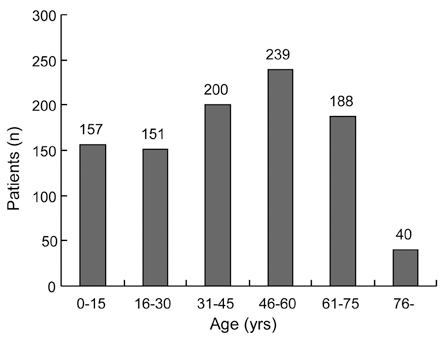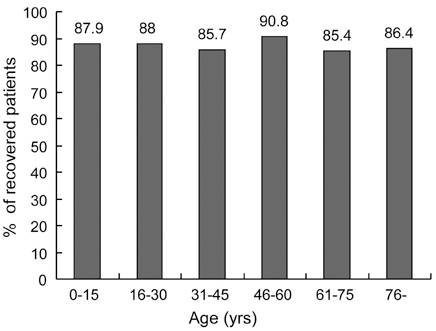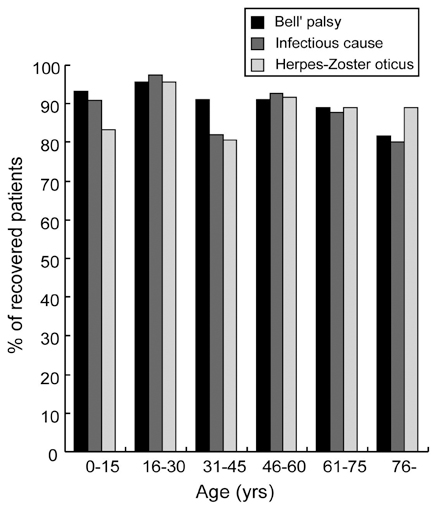Yonsei Med J.
2008 Oct;49(5):725-734. 10.3349/ymj.2008.49.5.725.
Comparison of Facial Nerve Paralysis in Adults and Children
- Affiliations
-
- 1Department of Otolaryngology, The College of Medicine, Kyung Hee University, Seoul, Korea. yeo2park@yahoo.co.kr
- KMID: 2158190
- DOI: http://doi.org/10.3349/ymj.2008.49.5.725
Abstract
- PURPOSE
Facial nerve injury can occur in the regions ranging from the cerebral cortex to the motor end plate in the face, and from many causes including trauma, viral infection, and idiopathic factors. Facial nerve paralysis in children, however, may differ from that in adults. We, therefore, evaluated its etiology and recovery rate in children and adults. MATERIALS AND METHODS: We retrospectively evaluated the records of 975 patients, ranging in age from 0 to 88 years, who displayed facial palsy at Kyung Hee Medical Center between January 1986 and July 2005. RESULTS: The most frequent causes of facial palsy in adults were Bell's palsy (54.9%), infection (26.8%), trauma (5.9%), iatrogenic (2.0%), and tumors (1.8%), whereas the most frequent causes of facial palsy in children were Bell's palsy (66.2%), infection (14.6%), trauma (13.4%), birth trauma (3.2%), and leukemia (1.3%). Recovery rates in adults were 91.4% for Bell's palsy, 89.0% for infection, and 64.3% for trauma, whereas recovery rates in children were 93.1% for Bell's palsy, 90.9% for infection, and 42.9% for trauma. CONCLUSION: These results show that causes of facial palsy are similar in adults and children, and recovery rates in adults and children are not significantly different.
Keyword
MeSH Terms
Figure
Cited by 1 articles
-
Comparison of Sudden Deafness in Adults and Children
Se Young Na, Myung Gu Kim, Seok Min Hong, Ji Hyun Chung, Ho Min Kang, Seung Geun Yeo
Clin Exp Otorhinolaryngol. 2014;7(3):165-169. doi: 10.3342/ceo.2014.7.3.165.
Reference
-
1. Kim IS, Shin SH, Kim J, Lee WS, Lee HK. Correlation between MRI and operative findings in Bell's palsy and Ramsay Hunt syndrome. Yonsei Med J. 2007. 48:963–968.
Article2. Danielidis V, Skevas S, Van Cauwenberge P, Vinck B. A comparative study of age and degree of facial nerve recovery in patients with Bell's palsy. Eur Arch Otorhinolaryngol. 1999. 256:520–522.
Article3. Ikeda M, Abiko Y, Kukimoto N, Omori H, Nakazato H, Ikeda K. Clinical factors that influence the prognosis of facial nerve paralysis and the magnitudes of influence. Laryngoscope. 2005. 115:855–860.
Article4. May M. May M, editor. Differential diagnosis by history, physical findings, and laboratory results: clinical-pathologica Correlation. The facial nerve. 1986. New York: Thieme Inc;181–216.5. Kim JS, Kim LS. Diagnosis and treatment of peripheral facial nerve paralysis. Seoul symposium. 1985. 1:153–206.6. Kerbavaz RJ, Hilsinger RL Jr, Adour KK. The facial paralysis prognostic index. Otolaryngol Head Neck Surg. 1983. 91:284–289.
Article7. Smith IM, Heath JP, Murray JA, Cull RE. Idiopathic facial(Bell's) palsy: a clinical survey of prognostic factors. Clin Otolaryngol Allied Sci. 1988. 13:17–23.8. Ko JY, Sheen TS, Hsu MM. Herpes zoster oticus treated with acyclovir and prednisolone: clinical manifestations and analysis of prognostic factors. Clin Otolaryngol Allied Sci. 2000. 25:139–142.
Article9. Gavilán C, Gavilán J, Rashad M, Gavilán M. Discriminant analysis in predicting prognosis of Bell's palsy. Acta Otolaryngol. 1988. 106:276–280.
Article10. Hydén D, Sandstedt P, Odkvist LM. Prognosis in Bell's palsy based on symptoms, signs and laboratory data. Acta Otolaryngol. 1982. 93:407–414.
Article11. Devriese PP, Schumacher T, Scheide A, de Jongh RH, Houtkooper JM. Incidence, prognosis and recovery of Bell's palsy. A survey of about 1000 patients (1974-1983). Clin Otolaryngol Allied Sci. 1990. 15:15–27.
Article12. Kim HN, Chang SO, Lee WS. Basic and clinical management. Facial nerve symposium. 1995. Seoul: Ilji Munwha Printing Co;129–175.13. May M, Shambaugh GE. Paparella MM, Shumrick DA, Gluckman JL, Meyerhoff WL, editors. Facial nerve paralysis. Otolaryngology. 1991. 3rd ed. Philadelphia: W.B. Saunders;1106.14. Lee DH, Chae YS, Park YS, Yeo SW. Prognostic value of electroneurography in Bell's palsy and Ramsay-Hunt's syndrome. Clin Otolaryngol. 2006. 31:144–148.
Article15. Peitersen E. Bell's palsy: The spontaneous course of 2,500 peripheral facial nerve palsies of different etiologies. Acta Otolaryngol Suppl. 2002. 549:4–30.
Article16. Adour KK, Wingerd J, Bell DN, Manning JJ, Hurley JP. Prednisone treatment for idiopathic facial paralysis (Bell's Palsy). N Engl J Med. 1972. 287:1268–1272.
Article17. May M, Wette R, Hardin WB Jr, Sullivan J. The use of steroids in Bell's palsy: a prospective controlled study. Laryngoscope. 1976. 86:1111–1122.18. Furuta Y, Fukuda S, Chida E, Takasu T, Ohtani F, Inuyama Y, et al. Reactivation of herpes simplex virus type I in patients with Bell's palsy. J Med Virol. 1998. 54:162–166.
Article19. Adour KK, Ruboyianes JM, Von Doersten GP, Byl FM, Trent CS, Quesenberry CP Jr, et al. Bell's palsy treatment acyclovir and prednisone compared with prednisone alone: a double-blind, randomized, controlled trial. Ann Otol Rhinol Laryngol. 1996. 105:371–378.
Article20. Hato N, Matsumoto S, Kisaki H, Takahashi H, Wakisaka H, Honda N, et al. Efficacy of early treatment of Bell's palsy with oral acyclovir and prednisolone. Otol Neurotol. 2003. 24:948–951.
Article21. Peitersen E. Natural history of Bell's palsy. Acta Otolaryngol Suppl. 1992. 492:122–124.
Article22. Julian GG, Hoffmann JF, Shelton C. Sugical rehabilitation of facial nerve paralysis. Otolaryngol Clin North Am. 1997. 30:701–726.23. Hoffman WY. Reanimation of the paralyzed face. Otolaryngol Clin North Am. 1992. 25:649–667.24. Tubbs RS, Louis RG Jr, Wartmann CT, Loukas M, Shoja MM, Ardalan MR, et al. Suprascapular nerve as a donor for extracranial facial nerve reanimation procedures: a cadaveric feasibility study. J Neurosurg. 2008. 108:145–148.
Article25. Balliet R. Payton OD, editor. Facial paralysis and other neuromuscular dysfunctions of the peripheral nervous system. Manual of physical therapy. 1989. New York, NY: Churchill Livingstone;175.26. Brach JS, VanSwearingen JM, Lenert J, Johnson PC. Facial neuromuscular retraining for oral synkinesis. Plast Reconstr Surg. 1997. 99:1922–1931. discussion 1932-3.
Article27. Ahn KH. Kim HN, Chang SO, Lee WS, editors. Rehabilitation of Bell's Palsy. Facial nerve symposium. Basic and clinical management. 1995. Seoul: Ilji Munwha Printing Co.;212–229.28. Cederwall E, Olseń MF, Hanner P, Fogdestam I. Evaluation of a physiotherapeutic treatment intervention in "Bell's" facial palsy. Physiother Theory Pract. 2006. 22:43–52.
Article29. Uri N, Greenberg E, Kitzes-Cohen R, Doweck I. Acyclovir in the treatment of Ramsay Hunt syndrome. Otolaryngol Head Neck Surg. 2003. 129:379–381.
Article30. Maslov B, Roje-Bedeković M, Miškov S, Demarin V. Acupuncture treatment in facial palsy-clinical observations. Acta Clin Croat. 2002. 43:275–279.




